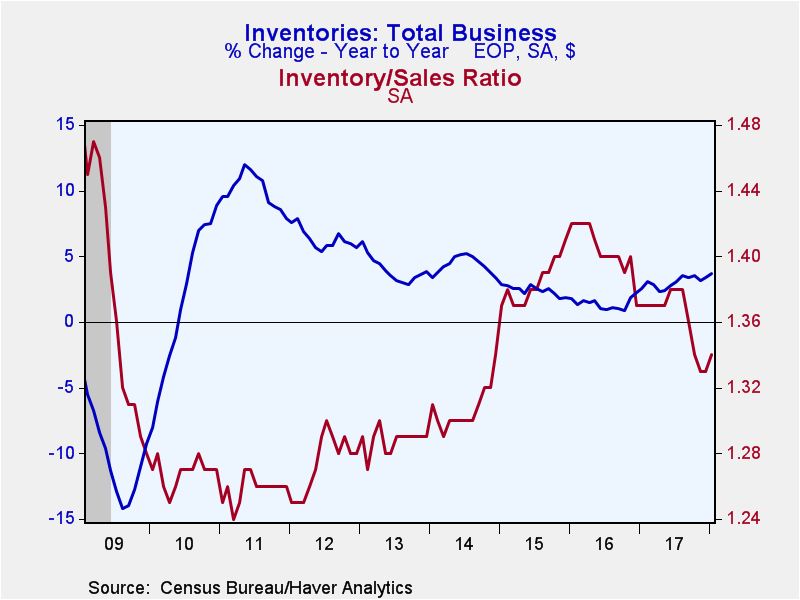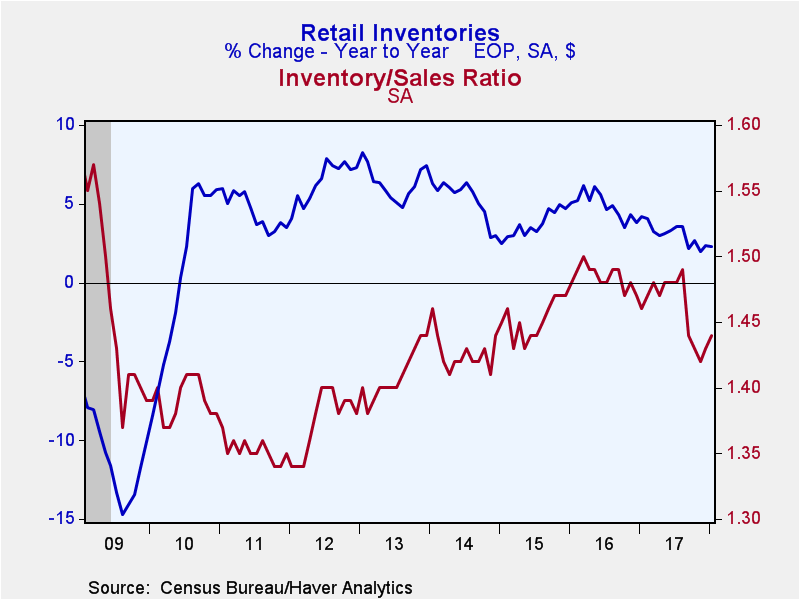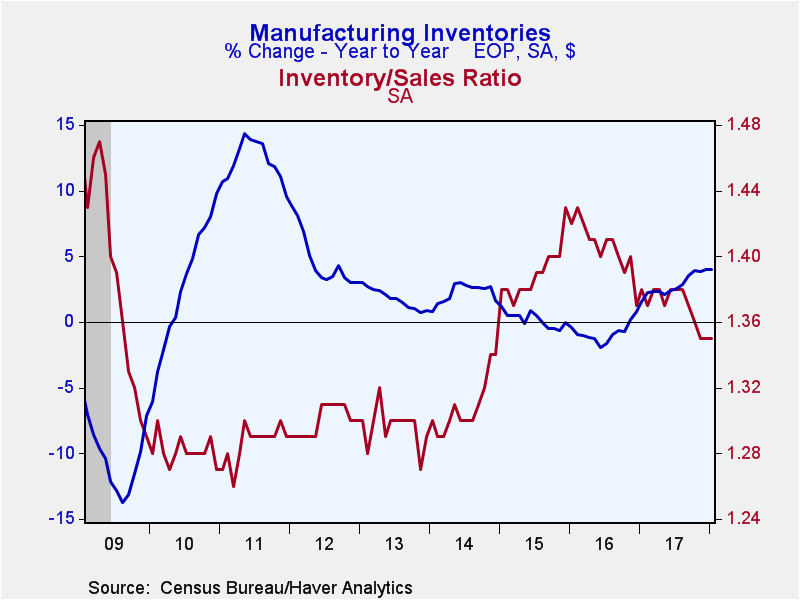 Global| Mar 14 2018
Global| Mar 14 2018U.S. Business Inventories Steadily Accumulate; Sales Ease
by:Tom Moeller
|in:Economy in Brief
Summary
Total business inventories increased 0.6% (3.7% y/y) during January, the same as in December, revised from 0.4%. Total business sales fell 0.2% (+5.7% y/y), the first decline since last March. The changes in inventories and sales [...]
Total business inventories increased 0.6% (3.7% y/y) during January, the same as in December, revised from 0.4%. Total business sales fell 0.2% (+5.7% y/y), the first decline since last March. The changes in inventories and sales caused the inventory-to-sales ratio to rise modestly to 1.34. That remained, however, well below its 1.42 peak early in 2016.
Retail inventories increased 0.7% (2.3% y/y) after a 0.3% rise. Auto inventories rose 1.7% (2.2% y/y) following four straight months of decline. Nonauto retail inventories notched 0.1% higher (2.4% y/y) after three months of firm accumulation. Grocery store inventories increased 0.2% (4.4% y/y) after surging in the prior two months. Building materials inventories rose 0.5% (3.8% y/y) after a -0.7% rise. Clothing store inventories gained 0.3% (-0.8% y/y), only the second m/m increase since last March. General merchandise inventories rose 0.7% (-0.3% y/y) after a 0.2% decline. Furniture store inventories declined 0.5% (+2.1% y/y), the third decline in four months. As reported last week, wholesale inventories increased 0.8% (4.8% y/y) in January following a 0.7% rise. Also reported earlier, factory sector inventories rose 0.3% (4.0% y/y), matching the weakest rise since May.
Retail sales slipped 0.1% (+4.1% y/y) following a 0.2% decline, while nonauto sales improved 0.1% (+4.7% y/y) after a 0.2% decline. Wholesale sector sales declined 1.1% (+6.7% y/y) after a 0.8% rise, as shipments from the factory sector increased a steady 0.6% (6.1% y/y).
The inventory-to-sales ratio in the retail sector rose to 1.44, the highest level in four months, but down sharply from the 1.49 August high. The nonauto I/S ratio held steady at 1.21 and remained near its lowest level since early-2012. The wholesale sector I/S ratio rose to 1.26, its highest point since September. In the manufacturing sector, the I/S ratio held steady at 1.35, its lowest point in three years.
The manufacturing and trade data are in Haver's USECON database.
| Manufacturing & Trade | Jan | Dec | Nov | Jan Y/Y | 2017 | 2016 | 2015 |
|---|---|---|---|---|---|---|---|
| Business Inventories (% chg) | 0.6 | 0.6 | 0.4 | 3.7 | 3.4 | 2.2 | 1.8 |
| Retail | 0.7 | 0.3 | 0.2 | 2.3 | 2.4 | 3.8 | 4.7 |
| Retail excl. Motor Vehicles | 0.1 | 0.6 | 0.4 | 2.4 | 2.2 | 1.6 | 3.8 |
| Merchant Wholesalers | 0.8 | 0.7 | 0.6 | 4.8 | 3.7 | 2.3 | 1.2 |
| Manufacturing | 0.3 | 0.7 | 0.5 | 4.0 | 4.0 | 0.8 | -0.1 |
| Business Sales (% chg) | |||||||
| Total | -0.2 | 0.5 | 1.4 | 5.7 | 6.1 | -0.1 | -3.2 |
| Retail | -0.1 | -0.2 | 0.8 | 4.1 | 4.8 | 2.6 | 1.9 |
| Retail excl. Motor Vehicles | 0.1 | -0.2 | 1.4 | 4.7 | 4.8 | 2.3 | 0.4 |
| Merchant Wholesalers | -1.1 | 0.8 | 1.9 | 6.7 | 8.1 | -0.6 | -4.9 |
| Manufacturing | 0.6 | 0.7 | 1.4 | 6.1 | 5.5 | -2.0 | -5.8 |
| I/S Ratio | |||||||
| Total | 1.34 | 1.33 | 1.33 | 1.37 | 1.38 | 1.40 | 1.38 |
| Retail | 1.44 | 1.43 | 1.42 | 1.46 | 1.46 | 1.48 | 1.45 |
| Retail excl. Motor Vehicles | 1.21 | 1.21 | 1.20 | 1.24 | 1.23 | 1.27 | 1.26 |
| Merchant Wholesalers | 1.26 | 1.23 | 1.23 | 1.28 | 1.27 | 1.33 | 1.32 |
| Manufacturing | 1.35 | 1.35 | 1.35 | 1.38 | 1.37 | 1.41 | 1.39 |
Tom Moeller
AuthorMore in Author Profile »Prior to joining Haver Analytics in 2000, Mr. Moeller worked as the Economist at Chancellor Capital Management from 1985 to 1999. There, he developed comprehensive economic forecasts and interpreted economic data for equity and fixed income portfolio managers. Also at Chancellor, Mr. Moeller worked as an equity analyst and was responsible for researching and rating companies in the economically sensitive automobile and housing industries for investment in Chancellor’s equity portfolio. Prior to joining Chancellor, Mr. Moeller was an Economist at Citibank from 1979 to 1984. He also analyzed pricing behavior in the metals industry for the Council on Wage and Price Stability in Washington, D.C. In 1999, Mr. Moeller received the award for most accurate forecast from the Forecasters' Club of New York. From 1990 to 1992 he was President of the New York Association for Business Economists. Mr. Moeller earned an M.B.A. in Finance from Fordham University, where he graduated in 1987. He holds a Bachelor of Arts in Economics from George Washington University.










